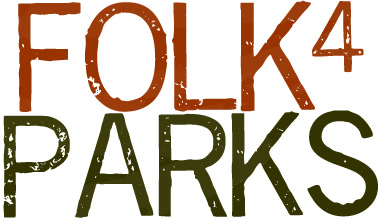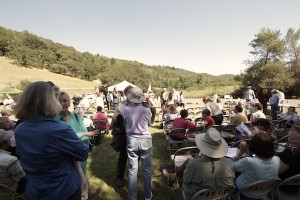One Plan To Prevent California State Park Closures
June 10, 2011
by Christopher Grant Ward
Folk4Parks.org
As the sun sets in front of me on Annadel State Park, the backdrop for an Friday evening outdoor strategy session on preventing CA State Parks closures, I'm left with one very salient fact: Unless we find $22 million, 70 specific parks will close on September 1, 2011.
Skip to the end to read how you can prevent CA Park Closures.
For the rest of you, in case you don't know what's been going on in California's backyard recently, I'll catch you up. 25% of CA State Parks are being closed in September. $22 million in budget cuts from Governor Brown have forced the closure of 70 CA State Parks on September 1. These cuts are intended to alleviate some of the worst economic hardships in the history of California. Keep in mind that the entire CA State Parks Budget represents 0.08% of the total California budget.
Public Opinion
Which brings us to this evening, where I've found myself with 200+ fellow park supporters in Spring Lake Park in San Rafael, CA. "CA State Parks were built, not closed, during the Great Depression", said Jared Huffman (D-San Rafael) to a crowd of activists, park organization leaders and concerned citizens in a makeshift outdoor amphitheater with nearby Annadel State Park serving as a well-suited backdrop and reminder of why we're all here.
Huffman's words set the tone for not just for Friday's two-hour public strategy session, but for the cause many of us have been fighting for many years. Tonight's session is focused on ways that AB 42, a bill put forward by Huffman that has already passed Assembly vote, might enable non-profit organizations to get involved directly in fundraising and support activities for individual parks.
The Case For Parks
But in a dire CA budget crisis, why bother to keep parks open?
"Because the average visitor to a State Park generates $58 for the local economy surrounding that park.", said John Severini, President of CA Travel Industry Association, a panelist who spoke vehemently on the subject. "Communities surrounding state parks live and die on the tourism economy generated CA parks."
Elizabeth Goldstein of the California State Parks Foundation also focused on this point, challenging the notion that these park closures could equate to any kind of monetary gain for the state, once the larger economic picture had been considered. "How can we afford to close state parks considering the economic impact to communities surrounding parks?", asked Goldstein.
Further, the closures have impact beyond the State Park system. "Some National Parks work so closely with State Parks that our operations are inseparable", said George Turnbull, Deputy Regional Director of the National Parks Service. "Tomales Bay is completely surrounded by Point Reyes. Del Norte Redwoods is the lynchpin for trails throughout Redwood National Parks. Closure of these state parks also threatens the livelihood of our National Parks." Indeed, the NPS website even gives their page the title of "Redwood National and State Parks". Given this relationship, there was some question as to whether these parks could be closed in any meaningful way.
Closed?
And what does "closed" mean anyhow? I've been asked, and wondered myself, about what "closures" meant for awhile and certainly it seemed the question was on everyone's minds. Many on the speaker panel agreed that "closing" a park doesn't literally equate to locking a gate. Rather, it means the removal of services. Services like ranger security, ecological stewardship, education programs and cleanup services. So what is going to happen when those services are gone, and people show up to pay and visit?
And just because there is no clear answer to some of these questions, I don't want anyone to get the idea that these park closures aren't going to happen. "I have no indication to believe that the Governor's budget cuts are not permanent," said Ruth Coleman, Director of the Department of Parks and Recreation. The message we'd like to express is that we are not closing parks, but rather that there are 70 parks we can't afford to operate anymore", said Ruth Coleman, Department of Parks and Recreation. "How can we creatively fill this gap?"
Here's The Plan.
Strategy
Make it as easy as possible for all individuals to give directly to specific California State parks that are scheduled for closure.
Argument
Consider that 4,190,793 people voted Yes on Prop 21: agreeing to pay $25 per registered license plate to keep parks open. If we assume an average of one car per voter, that's more or less $100m. And we only need $22m. Further, if AB 42 passes (and it's likely to pass) non-profits will be able to easily partner directly with parks and provide funds directly to those parks.
Click To Donate Directly to CA State Parks »
We've partnered with Givegoods.org, a 501(c)3 .orgs, to collect donations. Once AB 42 passes, Givegoods will do whatever it takes to pass funds along to state parks directly. This means TO THE PARKS THEMSELVES.
People keep asking Folk4Parks what they can do, and how can they get involved. We feel our plan is one good place to start. We're here to help advocates who want to step forward and start non-profits. In the coming week, we'll be setting up new tools for collecting donations directly from the public, and encouraging involvement from individuals and organizations that want to step in and fill this gap to keep these parks open after September 1.
If you feel strongly about this issue, and have more ideas, plase contact Folk4Parks to learn more about what we're doing to help raise money for these parks, how you can get involved and make a difference between now and September 1.
Leave a comment:



